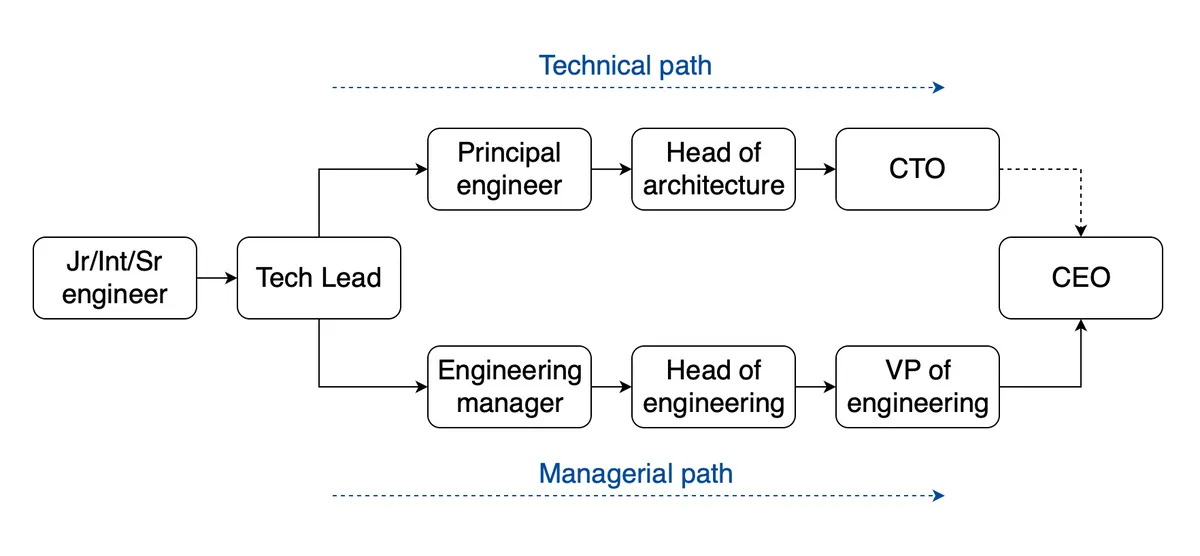Managers, leaders, and executives
A manager, a leader, and an executive, those terms are often used interchangeably and refer to the same type of person. And that’s fine in most situations. But, then again, titles are a bit of confetti words in software engineering industry and often thrown around aimlessly.
And so, although those terms can be used interchangeably, there is a specific connotation behind each of those. And today I wanted to dig into the subject a little bit and share my thinking.
The types of leaders
When we think about leaders in general terms, people often go for an image of a fearless alpha person charging in front of the pack, pushing through obstacles, and paving the way for the rest of the team.
But, then there are another types of leaders. There are grey cardinals types that lead from behind the scenes. There are secular leaders that appeal to the people’s inner strength. And then there are parents who navigate their children by being a responsible adult on their behalf. In their own ways they all tell other people what to do, meaning they lead them.
That brings us to the subject of leadership styles. All humans are different, and that includes leaders. Which results in different ways to lead people. Some get into everyone’s face, some lead by making sense, and some lead by being a BS shield for their team.
Leadership is a tough gig, and it takes everything out of a person to be effective in a leadership position. And so, naturally, people tend to play to their strengths, and, as a result, develop preferences, which in turn produce different types of leaders.
Roles of leaders
Personal preferences is only one half of the story though. Because any sufficiently large organisation requires a collection of different leadership roles to move forward.
A good example that we nerds can relate to is team based competitive online video games. A small team of say 3 people might entirely consist of three different types of leaders. There is a recurring pattern that repeats itself from a game to a game:
- a breach - a person who goes in first and causes the bulk of the initial damage
- a tactician - a person that keeps an eye of the overall situation, they usually have some sort of scanning capabilities
- a medic - the one who manages resources and heals others
Although the tactician is often referred to as the IGL (in game leader), each other person leads in their own speciality. IGL is more of a coordinator than the owner of the team. Coordination is their speciality.
And so, there are two halves to the story. There are individual strengths and personal preferences, but there are also different tasks and roles that need to be enacted in order for a team to be successful.
This pattern repeats itself not just in video games, but also in actual real life organisations. Because the underlying system which is the human nature is the same. And I hope you can now see how it relates to the subject of this article.
The managers
The role of a managers is to manage resources. And in terms of our little video games analogy, a manager is, in many ways, like a combat medic.
The role of a manager is to make sure the team doesn’t run out of resources and energy. And it’s a critical role in any organisation because others might not necessarily think of those matters deeply while in the midst of their own responsibilities.
Some managers act like secular leaders, they manage the situation by managing the people. And some other managers assume a balls buster stance, and manage through a stick and carrot incentives. But, ultimately, they all perform the same role, they set the team up for success by managing resources.
There is no real difference from the manager seniority level in this aspect. Whether that is a middle-management EM, or a general manager of the organisation. A CEO is usually expected to be a very good manager.
The leaders
If we continue with out little video game analogy, leaders are the ones who lead a change; commonly by breaking things. Some of them are nice about it, and some are not. But, the point of their work is the same: we need to break old things so that the new ones could have the room to grow.
If you want to address collected technical debt, hire a tech lead. Want to restructure an ecosystem, hire a principal engineer. Want to rebuild the engineering culture, hire a CTO.
The thing to understand about leaders is that they are not here to make friends. They are here to inflict damage. More likely than not they will make enemies. And so, just like in a video game a good breach should be paired with a combat medic; a good leader needs to be paired with a good manager who can help with sorting out the aftermath.

If you look at my engineering roles diagram, you can roughly think about it this way. The two pathways in the engineering career, the technical and the managerial ones, which roughly reflect this parity. There is technical leadership path, and then there is the engineering management one. Both have their role to play.
The executives
Now if we follow with my frivolous video games analogy, then the executives will be the tactician class. And here is where I need to slow down a little bit, because it gets messy. People upstairs tend to take it the wrong way when they are referred to as tactical rather than strategic. And people downstairs often don’t know what people upstairs really do for a living. So, let me dig it up bit by bit.
Generally speaking the term executive means someone with the power to execute plans and strategies. Whenever you listen to someone talking about business development matters, it is always the two: a strategy and the execution; both have their place in the company success. And so, as the term stands an executive is responsible for execution. Which puts them on the opposite side of strategy.
If you think about this way, then executives are essentially the top of the managerial hierarchy, and often referred to as the “top management”. But, confusingly, it is a mistake to think of them as managers. They are ex-managers, which is a different breed all together.
The role of an executive is to orchestrate the execution. They don’t lead the change, they don’t manage resources. Instead, they monitor, analyse, and coordinate the progress. They literally spend most of their time in reports and meetings. Which is a critical role in any complex situation.
And in that light, a CEO is an executive. VPoE is an executive. CTO, depending on an organisation, may or may not be an executive. In their pure form CTO is actually a strategist, the opposite of an executive.
The strategist (bonus material)
And so, if executives are the opposite of strategists, then who are the strategists? That’s a messy topic that deserves it’s own article, but I feel that I need to go through this quickly to round it up here.
If I would water it down very liberally, then we could say that a strategy as a set of rules that sits between a vision and actual plans. But, strategies are rather complex entities that include other strategies, such as functional strategies, people strategies, coordination strategies, risk-management strategies, etc. All of them together would form what’s known as a strategic context.
Think back to our video game analogy. Each speciality will have their own functional strategy how they’re going to enact their role in the team. That includes the IGL who needs a strategy for coordinating the team members to maximise their chances of winning the game.
Generally speaking it is the Head ofs who are responsible for creation of the
strategic context, but they never do that alone. The entire leadership team
needs to participate in the process of a strategy creation. The Head of’s job
is to put it in writing and then communicate the strategy to others. But, it
doesn’t mean that they are the ones who come up with the strategy.
A CTO in this context is a rather odd figure, because if a company has a high
functioning VPoE, then CTO will be more of a strategist than an executive. The
reason for this is that in a such large organisations, there will be multiple
independent departments led by the Head of’s, plus some for of R&D efforts and
such, and it is the CTO’s job to make sure that there is a consistent strategic
context between them.
A mixed bag of goodies
In real life there is rarely a clean cut between the three. People have mixed talents, and they can stretch to fill in for one or another role. Still the structure very much persists whenever groups of people involved in solving complex problems.
Some organisations acknowledge the difference between them and explicitly split leaders, managers, and executives into three different classes. Some others, might either not see the difference, or have no resources to split the responsibilities. And that is where the bulk of organisational problems tend to stem from.
A company hires a manager expecting them to be a leader. Or, they hire a leader where they wanted a manager and then act baffled that they start breaking things instead of managing resources. The most common case is that a company hires a leader to break and re-build something, but then can’t stomach the change and won’t have the leader’s back when they start roughing the feathers. All of those are avoidable problems if we think about the different leadership roles.
The important thing to understand here is that none of those roles are better than the other; more important than the other; or subordinate to one another. Some people are naturally better at one mode of operation than the other. And it’s the right combination of people and traits that makes a team tick.
Wrapping up
Well, that’s all I have for you for now. I hope it was helpful, or at least entertaining.
I’ll see you all in the next one.
